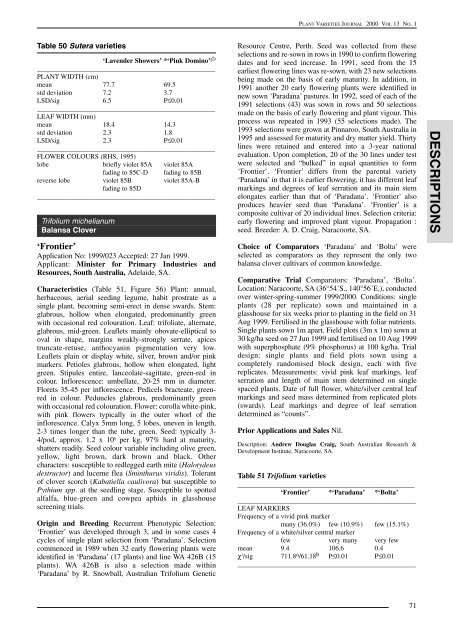53. Volume 13- Number 1 - IP Australia
53. Volume 13- Number 1 - IP Australia
53. Volume 13- Number 1 - IP Australia
Create successful ePaper yourself
Turn your PDF publications into a flip-book with our unique Google optimized e-Paper software.
DESCR<strong>IP</strong>TIONS<br />
PLANT VARIETIES JOURNAL 2000 VOL <strong>13</strong> NO. 1<br />
Table 50 Sutera varieties<br />
‘Lavender Showers’ *‘Pink Domino’ A<br />
____________________________________________________<br />
PLANT WIDTH (cm)<br />
mean 77.7 69.5<br />
std deviation 7.2 3.7<br />
LSD/sig 6.5 P≤0.01<br />
____________________________________________________<br />
LEAF WIDTH (mm)<br />
mean 18.4 14.3<br />
std deviation 2.3 1.8<br />
LSD/sig 2.3 P≤0.01<br />
____________________________________________________<br />
FLOWER COLOURS (RHS, 1995)<br />
lobe briefly violet 85A violet 85A<br />
fading to 85C-D fading to 85B<br />
reverse lobe violet 85B violet 85A-B<br />
fading to 85D<br />
____________________________________________________<br />
Trifolium michelianum<br />
Balansa Clover<br />
‘Frontier’<br />
Application No: 1999/023 Accepted: 27 Jan 1999.<br />
Applicant: Minister for Primary Industries and<br />
Resources, South <strong>Australia</strong>, Adelaide, SA.<br />
Characteristics (Table 51, Figure 56) Plant: annual,<br />
herbaceous, aerial seeding legume, habit prostrate as a<br />
single plant, becoming semi-erect in dense swards. Stem:<br />
glabrous, hollow when elongated, predominantly green<br />
with occasional red colouration. Leaf: trifoliate, alternate,<br />
glabrous, mid-green. Leaflets mainly obovate-elliptical to<br />
oval in shape, margins weakly-strongly serrate, apices<br />
truncate-retuse, anthocyanin pigmentation very low.<br />
Leaflets plain or display white, silver, brown and/or pink<br />
markers. Petioles glabrous, hollow when elongated, light<br />
green. Stipules entire, lanceolate-sagittate, green-red in<br />
colour. Inflorescence: umbellate, 20-25 mm in diameter.<br />
Florets 35-45 per inflorescence. Pedicels bracteate, greenred<br />
in colour. Peduncles glabrous, predominantly green<br />
with occasional red colouration. Flower: corolla white-pink,<br />
with pink flowers typically in the outer whorl of the<br />
inflorescence. Calyx 5mm long, 5 lobes, uneven in length,<br />
2-3 times longer than the tube, green. Seed: typically 3-<br />
4/pod, approx. 1.2 x 10 6 per kg, 97% hard at maturity,<br />
shatters readily. Seed colour variable including olive green,<br />
yellow, light brown, dark brown and black. Other<br />
characters: susceptible to redlegged earth mite (Halotydeus<br />
destructor) and lucerne flea (Sminthurus viridis). Tolerant<br />
of clover scorch (Kabatiella caulivora) but susceptible to<br />
Pythium spp. at the seedling stage. Susceptible to spotted<br />
alfalfa, blue-green and cowpea aphids in glasshouse<br />
screening trials.<br />
Origin and Breeding Recurrent Phenotypic Selection:<br />
‘Frontier’ was developed through 3, and in some cases 4<br />
cycles of single plant selection from ‘Paradana’. Selection<br />
commenced in 1989 when 32 early flowering plants were<br />
identified in ‘Paradana’ (17 plants) and line WA 426B (15<br />
plants). WA 426B is also a selection made within<br />
‘Paradana’ by R. Snowball, <strong>Australia</strong>n Trifolium Genetic<br />
Resource Centre, Perth. Seed was collected from these<br />
selections and re-sown in rows in 1990 to confirm flowering<br />
dates and for seed increase. In 1991, seed from the 15<br />
earliest flowering lines was re-sown, with 23 new selections<br />
being made on the basis of early maturity. In addition, in<br />
1991 another 20 early flowering plants were identified in<br />
new sown ‘Paradana’ pastures. In 1992, seed of each of the<br />
1991 selections (43) was sown in rows and 50 selections<br />
made on the basis of early flowering and plant vigour. This<br />
process was repeated in 1993 (55 selections made). The<br />
1993 selections were grown at Pinnaroo, South <strong>Australia</strong> in<br />
1995 and assessed for maturity and dry matter yield. Thirty<br />
lines were retained and entered into a 3-year national<br />
evaluation. Upon completion, 20 of the 30 lines under test<br />
were selected and “bulked” in equal quantities to form<br />
‘Frontier’. ‘Frontier’ differs from the parental variety<br />
‘Paradana’ in that it is earlier flowering, it has different leaf<br />
markings and degrees of leaf serration and its main stem<br />
elongates earlier than that of ‘Paradana’. ‘Frontier’ also<br />
produces heavier seed than ‘Paradana’. ‘Frontier’ is a<br />
composite cultivar of 20 individual lines. Selection criteria:<br />
early flowering and improved plant vigour. Propagation :<br />
seed. Breeder: A. D. Craig, Naracoorte, SA.<br />
Choice of Comparators ‘Paradana’ and ‘Bolta’ were<br />
selected as comparators as they represent the only two<br />
balansa clover cultivars of common knowledge.<br />
Comparative Trial Comparators: ‘Paradana’, ‘Bolta’.<br />
Location: Naracoorte, SA (36°54´S., 140°56´E.), conducted<br />
over winter-spring-summer 1999/2000. Conditions: single<br />
plants (28 per replicate) sown and maintained in a<br />
glasshouse for six weeks prior to planting in the field on 31<br />
Aug 1999. Fertilised in the glasshouse with foliar nutrients.<br />
Single plants sown 1m apart. Field plots (3m x 1m) sown at<br />
30 kg/ha seed on 27 Jun 1999 and fertilised on 10 Aug 1999<br />
with superphosphate (9% phosphorus) at 100 kg/ha. Trial<br />
design: single plants and field plots sown using a<br />
completely randomised block design, each with five<br />
replicates. Measurements: vivid pink leaf markings, leaf<br />
serration and length of main stem determined on single<br />
spaced plants. Date of full flower, white/silver central leaf<br />
markings and seed mass determined from replicated plots<br />
(swards). Leaf markings and degree of leaf serration<br />
determined as “counts”.<br />
Prior Applications and Sales Nil.<br />
Description: Andrew Douglas Craig, South <strong>Australia</strong>n Research &<br />
Development Institute, Naracoorte, SA.<br />
Table 51 Trifolium varieties<br />
_______________________________________________<br />
‘Frontier’ *‘Paradana’ *‘Bolta’<br />
____________________________________________________<br />
LEAF MARKERS<br />
Frequency of a vivid pink marker<br />
many (36.0%) few (10.9%) few (15.1%)<br />
Frequency of a white/silver central marker<br />
few very many very few<br />
mean 9.4 106.6 0.4<br />
χ 2 /sig 711.8 a /61.18 b P≤0.01 P≤0.01<br />
____________________________________________________<br />
71

















